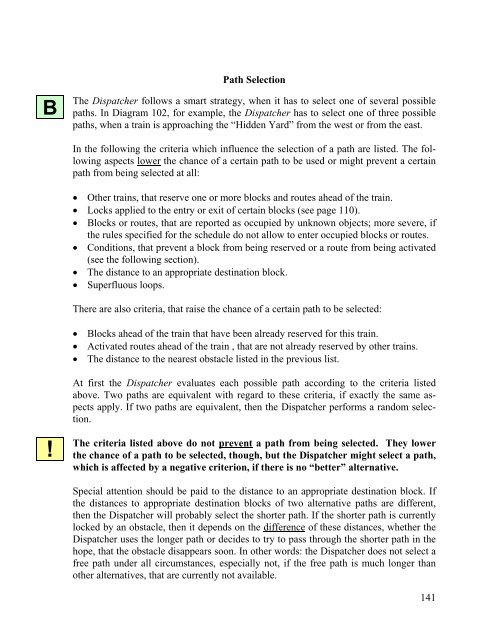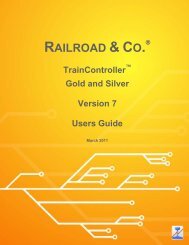Download - Freiwald Software
Download - Freiwald Software
Download - Freiwald Software
Create successful ePaper yourself
Turn your PDF publications into a flip-book with our unique Google optimized e-Paper software.
B<br />
!<br />
Path Selection<br />
The Dispatcher follows a smart strategy, when it has to select one of several possible<br />
paths. In Diagram 102, for example, the Dispatcher has to select one of three possible<br />
paths, when a train is approaching the “Hidden Yard” from the west or from the east.<br />
In the following the criteria which influence the selection of a path are listed. The following<br />
aspects lower the chance of a certain path to be used or might prevent a certain<br />
path from being selected at all:<br />
• Other trains, that reserve one or more blocks and routes ahead of the train.<br />
• Locks applied to the entry or exit of certain blocks (see page 110).<br />
• Blocks or routes, that are reported as occupied by unknown objects; more severe, if<br />
the rules specified for the schedule do not allow to enter occupied blocks or routes.<br />
• Conditions, that prevent a block from being reserved or a route from being activated<br />
(see the following section).<br />
• The distance to an appropriate destination block.<br />
• Superfluous loops.<br />
There are also criteria, that raise the chance of a certain path to be selected:<br />
• Blocks ahead of the train that have been already reserved for this train.<br />
• Activated routes ahead of the train , that are not already reserved by other trains.<br />
• The distance to the nearest obstacle listed in the previous list.<br />
At first the Dispatcher evaluates each possible path according to the criteria listed<br />
above. Two paths are equivalent with regard to these criteria, if exactly the same aspects<br />
apply. If two paths are equivalent, then the Dispatcher performs a random selection.<br />
The criteria listed above do not prevent a path from being selected. They lower<br />
the chance of a path to be selected, though, but the Dispatcher might select a path,<br />
which is affected by a negative criterion, if there is no “better” alternative.<br />
Special attention should be paid to the distance to an appropriate destination block. If<br />
the distances to appropriate destination blocks of two alternative paths are different,<br />
then the Dispatcher will probably select the shorter path. If the shorter path is currently<br />
locked by an obstacle, then it depends on the difference of these distances, whether the<br />
Dispatcher uses the longer path or decides to try to pass through the shorter path in the<br />
hope, that the obstacle disappears soon. In other words: the Dispatcher does not select a<br />
free path under all circumstances, especially not, if the free path is much longer than<br />
other alternatives, that are currently not available.<br />
141










